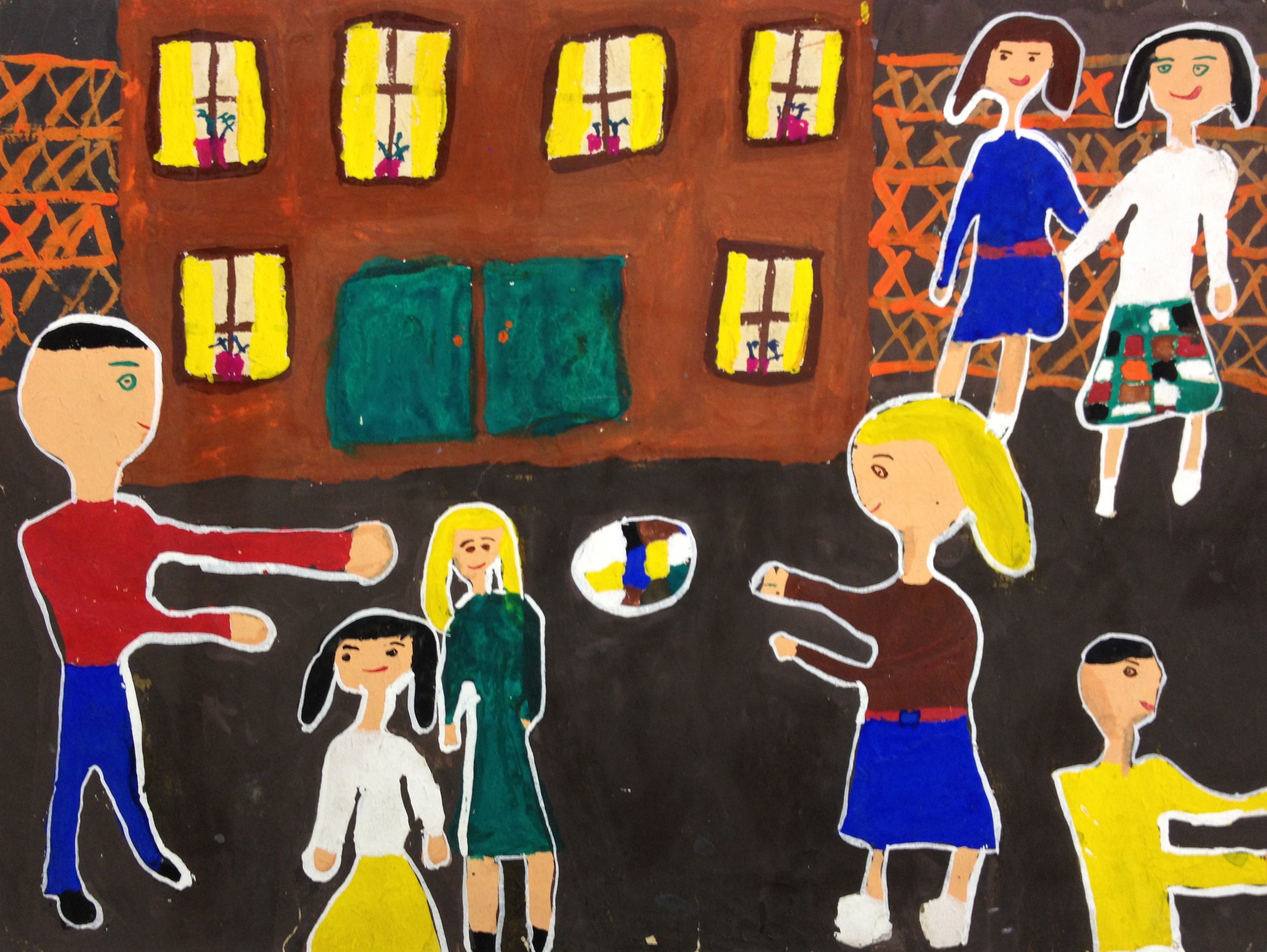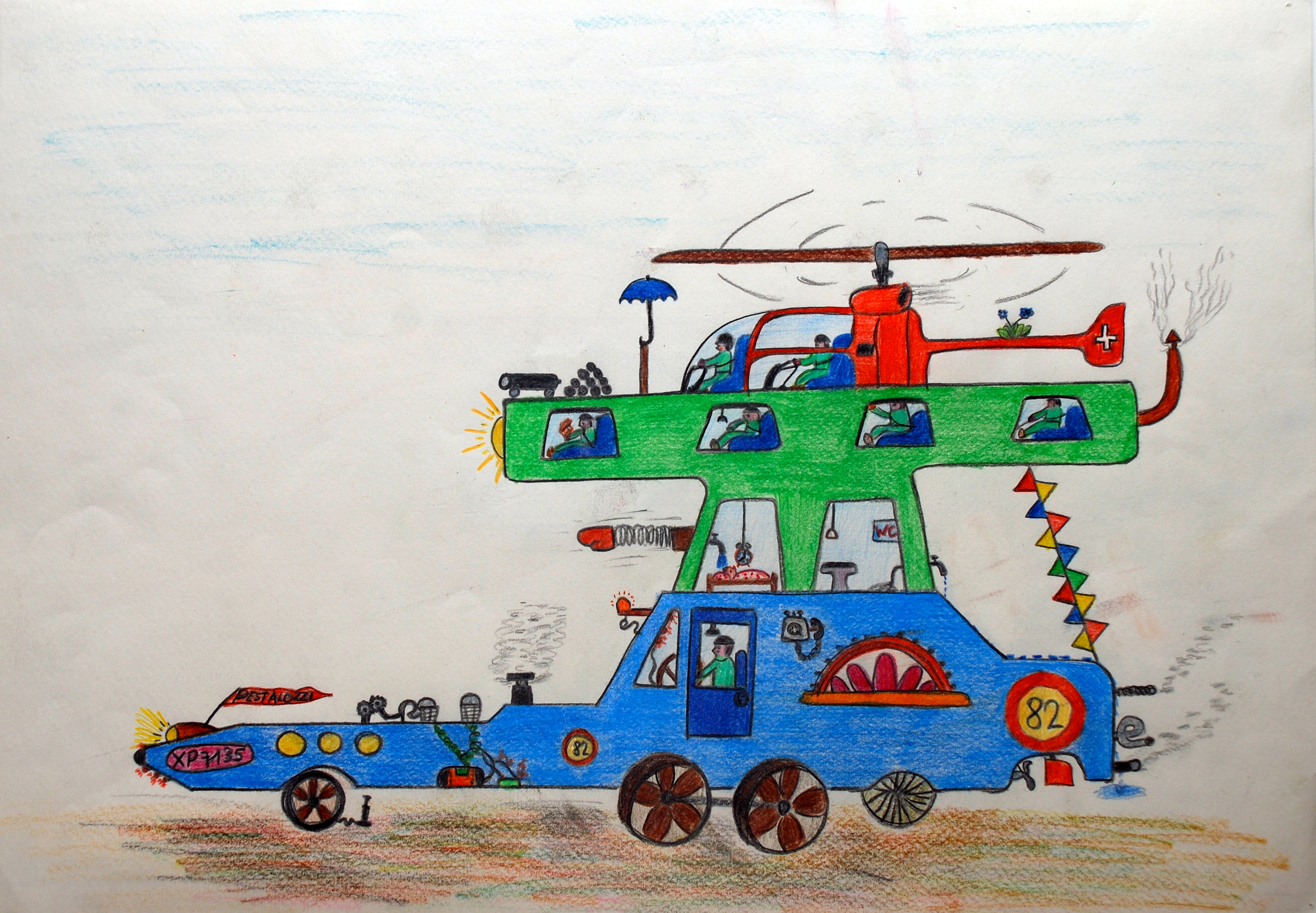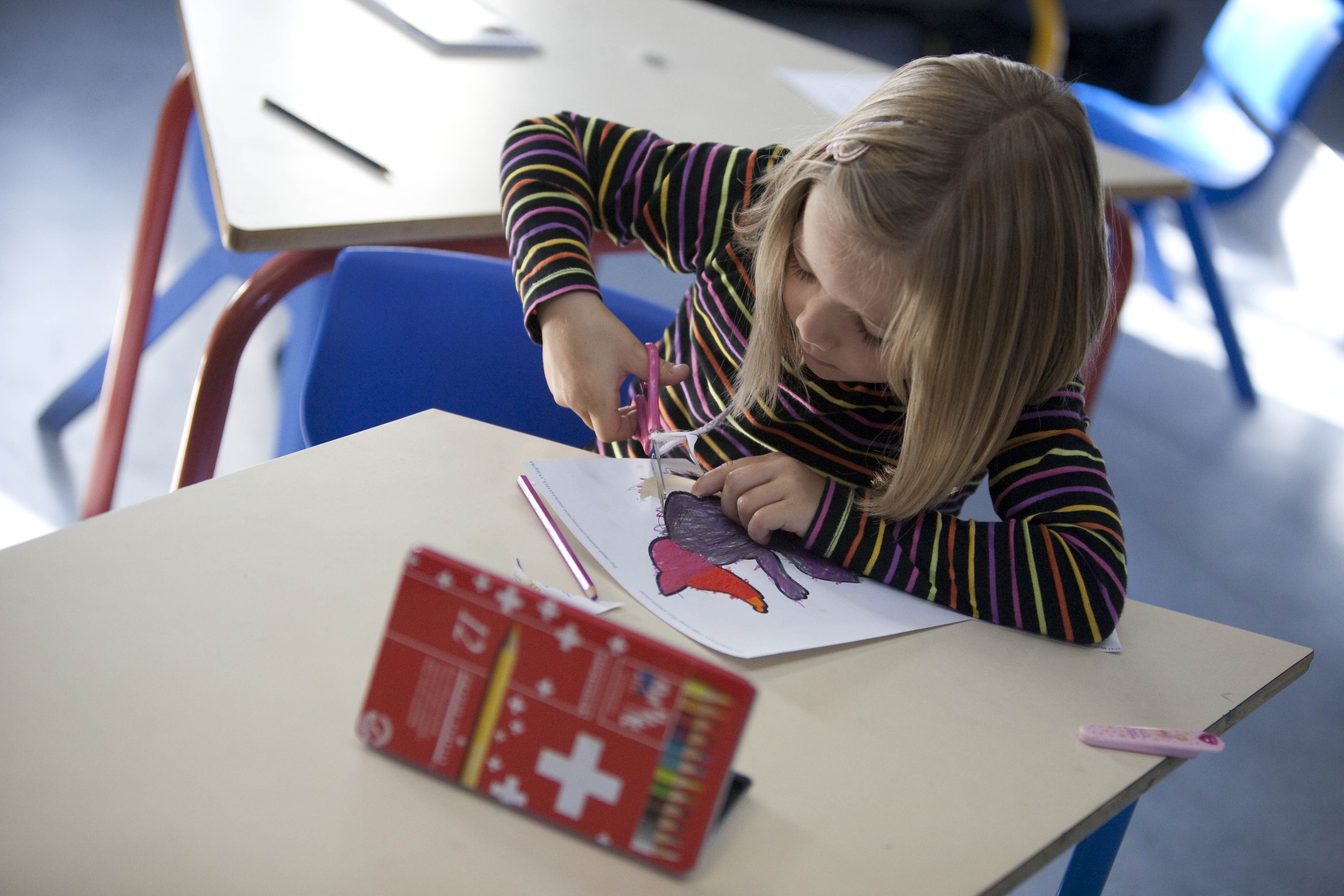A century seen through children’s eyes

Over 50,000 drawings by children are stored in a vault in Zurich. An art historian has been studying them to find out how they reflect the past century’s social, political and educational changes. The odd famous name can be recognised among them.
Anna Lehninger moves briskly around the storage room on the outskirts of Zurich. She climbs a shaky ladder, opens cardboard boxes and drawers, leafs through them for several minutes and comes back with a selection of sheets of paper. She arranges them in order, studies them intently and then, as so often happens here, her face registers surprise.
What she has in front of her are collages made with cut-outs from the glossy magazines and catalogues that started coming into Swiss homes with the economic boom. The children’s drawn figures look like modern-day Frankensteins, and evoke an era, just like the thousands of other works in the archive of the Pestalozzianum Foundation in Oerlikon.
The 33-year-old is regularly caught off-guard by the works here. Like the day when, quite by chance, she found the drawings of the young Friedrich Dürrenmatt, who as an adult wrote plays like The Visit and The Physicists that made him famous throughout the world.
There are six drawings done in pencil, coloured pencils and ink which recall his youthful passion for painting, history and noble characters. Dated 1934, the sketches represent intrepid figures like American Indians, or Adrian von Bubenberg, the legendary defender of the city of Morat during the Burgundian siege of 1476.
“To tell you the truth, I was looking for another picture by Dürrenmatt, published in a Pestalozzi school calendar in the 1930s, in which he depicted a historic Swiss battle. I still have not found that one, and I fear that it is no longer in the collection,” explains Lehninger.
The 13-year-old ‘Fritz’ Dürrenmatt (as he signed his name on the back) sent in his work for the annual art competition. He may have done it with a heavy heart.
“Dürrenmatt had already entered the contest, winning first prize – a pocket watch. But when he unpacked his prize, full of excitement, he let the precious watch fall on the floor and it broke. So probably he was sending in these six drawings in the hope of getting another watch. But this time the jury only gave him an honourable mention,” recounts Lehninger.
Dürrenmatt’s are not the only treasures contained in the archive. Lehninger has found a pencil sketch by the son of Albert Einstein, the 13-year-old Eduard; an engraving by Celestino Piatti, a respected graphic artist and painter from canton Ticino; a picture of the Swiss cartoon character Globi by the future finance minister Kaspar Villiger and later chairman of UBS.

More
How children draw the world
Mirroring events and changes
The archive is surprising not only because of the odd well-known name that turns up, but above all because of the richness and variety it contains. The 50,000 pictures come from 25 countries.
Works were produced during art classes or for an art competition in Switzerland or elsewhere. The Pestalozzianum Foundation collection is one of the main such archives in Europe, with others in Vienna, Prague, Mannheim and Lausanne.
Leafing through the drawings one can trace the passing of time, relive landmark events over the last century, see changes in society reflected, and appreciate how the teaching of art in schools has evolved. “There is enough material here for decades of research. It is fascinating to see how children gave expression to the reality surrounding them,” says Lehninger.
The 20th century was certainly not without epoch-making events. Some of them particularly struck the imagination of these young artists. They are very much aware of the Second World War – represented by fathers, uncles, and cousins in uniform, military weapons, and the struggle to bring in the harvest during wartime; later on this focus gives way to sporting competitions, then the first moon landing.
The pictures also reflect social processes, especially within the family. “Whereas up till the 1960s roles in the home were well defined and respected tradition, from the 1960s on, children drew the father working in the kitchen, or feeding the baby its bottle, while the mother drives a car,” says Lehninger.
Taken out of their boxes, these pictures reflect a turbulent century. Lehninger searches through the light pencil lines, the heavy brush strokes, the bold collages, for history seen through children’s eyes, as a bust of Pestalozzi, the prince of educational reformers, serenely gazes down.

More
Art is ‘vital’ for children’s cognitive development
The archive of drawings by children and young people is part of the collections of the Pestalozzianum Foundation of Zurich. It includes about 50,000 pictures.
Started in 1932 as an “International Institute for the Study of Young People’s Art”, the archive had the goal of documenting the development of art teaching in schools. Its first director, Jakob Weidmann (1897-1975), aimed to revolutionise art education, liberating it from the traditional exercise of copying models.
To this end, Weidmann maintained ongoing contact with teachers in other countries such as Japan, Sweden and India.
The art teacher and reformer collaborated with these countries in mounting several travelling exhibitions to spread the new concept of art education.
As the decades went by, the archive was enriched by new private collections, including that of the Pestalozzi calendar competition (22,000 pictures) and other private holdings (14,000 pictures).
Of the 50,000 pictures only 400 have been digitised so far. The Pestalozzianum Foundation hopes to be able to continue the inventory and cataloguing of the holdings.
Since August 2012, Anna Lehninger, an art historian and project worker at the Institute for Popular Culture Studies at the University of Zurich, has been analysing the pictures from a cultural anthropology perspective. The collection is also available to other researchers.
The Oerlikon archive is a representative cross-section of children’s art from the past century. The collection contains drawings by children from every continent, though not all countries are equally represented.
“The large collection of pictures from some countries like Sweden and Japan helps us to understand the teaching methods and syllabuses of particular teachers, schools and classes,” explains Lehninger.
“We can compare art education abroad with that in Switzerland, noting the similarities and the differences. For example in the 1930s, the teaching approach in Czechoslovakia was just like the approach followed in Zurich. But at the same time, pictures from a class in Munich were already showing signs of the ideology and expressive style of Nazism.”
The Institute’s first director, Jakob Weidmann, dedicated himself to matching other similar institutions around the world. Weidmann intended his work to promote world peace through exchange of drawings between children of different races and languages.
Today, collaboration with other similar collections has become infrequent. In future, the Pestalozzianum Foundation intends to intensify these exchanges so as to find drawings by Swiss children in archives abroad and to understand what influence the travelling exhibitions organised by the Swiss Institute may have had on the teaching of art in other countries.
(Translated from Italian by Terence MacNamee)

In compliance with the JTI standards
More: SWI swissinfo.ch certified by the Journalism Trust Initiative








You can find an overview of ongoing debates with our journalists here . Please join us!
If you want to start a conversation about a topic raised in this article or want to report factual errors, email us at english@swissinfo.ch.